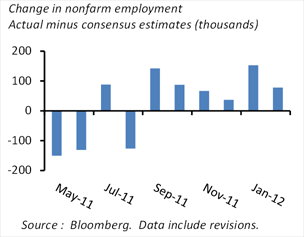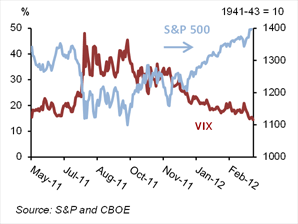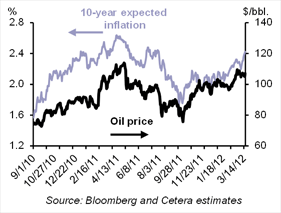Second Quarter Outlook An Improving Outlook for Growth
Given the weak economy and stunning stock market volatility last year, it is only natural that expectations at the beginning of 2012 were subdued. The consensus among market strategists surveyed by Barrons in late December was that the S&P 500 would end 2012 at around 1360. Instead, the S&P 500 took off and as of March 16, was trading at 1404. In other words, it took the market fewer than ten weeks to blow past the level the consensus thought would take the entire year to reach.
The question now is whether the market has gotten ahead of itself. A good place to begin is by asking what is different. Last year, economists and strategists started out on an optimistic note, only to have hopes dashed by a series of shocks. These included the Tsunami in Japan and flooding in Thailand that disrupted production supply chains worldwide, a spike in oil and gasoline prices, gridlock on the debt ceiling in Washington, and an apparent lack of progress in Europe in resolving its debt crisis.
The picture that emerged was one of a global economy that was trying to work its way through the after effects of the financial crisis and recession, only to be set back by a number of sudden shocks. Once those shocks abated, the economy responded with surprising strength. The job gains in the United States in the past three months, for example, have been the largest of any three-month period since 2006, and the gains have now exceeded economists’ estimates for six months in a row (Exhibit 1). The improvement in the labor market, meanwhile, is being reflected elsewhere in the U.S. economy, including increases in retail sales, housing starts and home sales (though from quite low levels), and industrial production. Europe appears to be in the midst of a mild recession, but monetary easing in Brazil, India, and China is on track to keep growth in those key emerging markets from declining too precipitously. Debt issues, meanwhile, have moved to the back burner in the United States, and the European Union has, after many fits and starts, made progress in resolving its crisis, including a debt reduction agreement and bailout package for Greece.
Exhibit 1
Job growth has been stronger than expected recently | 
|
These economic and political developments have led to a decline in the VIX index of expected future stock market volatility implied by options prices – often referred to as the “fear gauge.” Last summer the VIX jumped to over 40, which typically occurs only in periods of severe financial stress (Exhibit 2). It remained elevated through November before edging down, and as of mid-March 2012 stands at 14, which is lower than its historical average. The market, to all appearances, is no longer worried about a sell-off in coming months.
Exhibit 2
The stock market has risen as volatility – and fear – have subsided | 
|
Smooth sailing from here?
While last year’s uncertainty seems to have subsided, investors may be forgiven if they cannot quite bring themselves to believe the recovery in the economy and the markets are real. Many investors are still heavily invested in low-yielding CDs and Treasury securities. This may be because there is no assurance that all of the shocks that roiled the markets last year were one-off affairs. Indeed, it would be a surprise if some did not reappear. Some of the key issues that are likely to affect the markets in coming months, in our view, include the following: - Increased volatility ahead of the presidential election. Since 1900, the stock market has tended – with some major exceptions – to start off on a strong footing at the beginning of each presidential election year, only to lose steam during the summer, then pick up again in the months just before and after the election. This pattern is consistent with a reduction of uncertainty as the election draws near, and could be repeated again, barring another financial crisis such as the one that occurred in 2008. But even if events were to follow the script from past election years, it would mean months of volatility before any sustained gains.
- Debt reduction in Europe and the United States. The agreement between the Administration and Congress on the extension of the debt ceiling in July of last year means that, under current trends, that ceiling will not be reached again until sometime in 2013. But the budgetary issues that underlie the debt issues – including whether the Bush-era tax cuts will be extended at the end of 2012 – have not gone away and could give rise to considerable market turmoil before the end of this year. The progress the European Union has made in resolving its debt crisis, meanwhile, has surprised its many skeptics on both sides of the Atlantic, but agreement has yet to be reached on a long-term plan for preventing future defaults.
- Higher oil and gasoline prices. With oil prices on the rise again – seemingly retracing last spring’s spike to almost $115 – the question is whether consumers will cut back on expenses to offset higher energy prices, reducing GDP growth in the process. Here a cautious answer can be provided: Yes – but not as much as they would have if prices had not spiked last spring. The reason is that much of the adjustment on the part of households to higher energy prices has already occurred in that buyers have shifted toward vehicles that consume less gasoline. This can be seen most recently in January’s motor vehicle sales numbers, in which sales of cars rose almost 18%, while sales of light trucks, which do not tend to get as good gas mileage, fell 5%.
- Inflation. The most recent consumer price and labor reports showed little sign that inflation is on the rise. In February core inflation (CPI inflation excluding the volatile food and energy components) rose at a 2.2% rate over a year ago, while wages rose at a 1.9% rate – meaning that real wages are dropping. Inflation remains muted because with 8.3% unemployment, the economy is still operating well below the level at which wage and price pressures begin to build. Still, the markets do not believe that low inflation and low interest rates will persist forever. Indeed, the inflation rate the Treasury market expects to prevail over the next ten years (as implied by the difference between nominal Treasury and TIPS yields) has risen steadily in recent months, reflecting, in part, higher oil prices (Exhibit 3). If the market is right, it will not be long before it begins pricing in a Fed change in its intent to keep policy interest rates low until well into 2014.
Exhibit 3
Inflation expectations have been tracking oil prices | 
|
Implications for investors.
Putting it all together, our view is that economic growth is picking up in the United States and that while it has not been fatally damaged abroad, the economy and the markets still face headwinds. This argues for a substantial allocation to equities, for favoring bonds that provide a cushion in the form of a spread over U.S. Treasuries, and for diversification into alternative investments. Within equities we would not pare back allocations to dividend-paying stocks too much – the dividends may yet prove to be welcome if volatility rises to levels anything like last year’s. But the improved outlook for growth is likely to favor stocks in cyclical sectors, especially those with a large portion of sales abroad: energy, consumer discretionary, industrials, materials, and technology.
| Prepared by: | Brian Gendreau, Market Strategist
Cetera Financial Group |
This information compiled by Cetera Financial Group is believed to be from reliable sources; however, we make no representation as to its completeness or accuracy. The information has been selected to objectively convey the key drivers and catalysts standing behind current market direction and sentiment.
No independent analysis has been performed and the material should not be construed as investment advice. Investment decisions should not be based on this material since the information contained here is a singular news update, and prudent investment decisions require the analysis of a much broader collection of facts and context. All economic and performance information is historical and not indicative of future results. Investors cannot invest directly in indices. This is not an offer, recommendation or solicitation of an offer to buy or sell any security and investment in any security covered in this material may not be advisable or suitable. Please consult your financial professional for more information.
While diversification may help reduce volatility and risk, it does not guarantee future performance. Additional risks are associated with international investing, such as currency fluctuations, political and economic instability, and differences in accounting standards.
Securities and insurance products are offered by PRIMEVEST Financial Services, Inc., a registered broker/dealer. Member FINRA/SIPC. PRIMEVEST Financial Services is unaffiliated with the financial institution where investment services are offered. Investment products are * Not FDIC/NCUSIF insured *May lose value *Not bank guaranteed *Not a deposit * Not insured by any federal government agency. |



